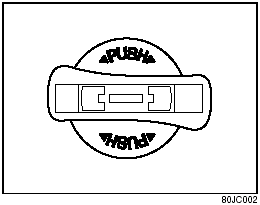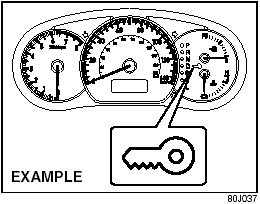Starting the Engine
Before Starting the Engine
1) Make sure the parking brake is set fully.
2) Manual Transaxle – Shift into “N” (Neutral) and depress the clutch pedal all the way to the floor.
Hold the clutch pedal while starting the engine.
Automatic Transaxle – If the gearshift lever is not in “P” (Park) position, shift into “P”. (If you need to re-start the engine while the vehicle is moving, shift into “N”.)
NOTE:
The engine of manual transaxle vehicle will
not start unless the clutch pedal is
depressed.
NOTE:
Automatic transaxle vehicles have a starter
interlock device which is designed to keep
the starter from operating if the transaxle is
in any of the drive positions.

WARNING:
Make sure that the parking brake is
set fully and the transaxle is in Neutral
(or Park for vehicles with an automatic
transaxle) before attempting to
start the engine.
Starting a Cold Engine
With your foot off the accelerator pedal, crank the engine by turning the ignition key to “START”. Release the key when the engine starts.
CAUTION:
• Stop turning the starter immediately
after the engine has started or
the starter system can be damaged.
• Do not crank the engine for more than 15 seconds at a time. If the engine doesn’t start on the first try, wait about 15 seconds before trying again.
If the engine does not start after 15 seconds of cranking, wait about 15 seconds, then press down the accelerator pedal to 1/3 of its travel and try cranking the engine again. Release the key and accelerator pedal when the engine starts.
If the engine still does not start, try holding the accelerator pedal all the way to the floor while cranking. This should clear the engine if it is flooded.
If you are unable to start the engine using this procedure, consult your SUZUKI dealer.
Starting a Warm Engine
Use the same procedure as for “Starting a Cold Engine”.

Vehicle With Keyless Start System
The ignition switch can be operated without using an ignition key when the remote controller is in an area of the vehicle other than the rear luggage area. To turn the ignition switch, first push in the switch.
NOTE:
You must push in the ignition switch to turn
it from the “LOCK” position to the “ACC”
position. To return to the “LOCK” position
from the “ACC” position, turn the ignition
switch counterclockwise while pushing in
the switch.

If the keyless start system blue indicator light illuminates on the instrument cluster, you can turn the ignition switch. If the red indicator light illuminates, you can not turn the ignition switch.
NOTE:
• The ignition switch can be turned to the
“ACC” position when the keyless start
system blue indicator light illuminates.
The blue indicator light will illuminate for several seconds when you push in the ignition switch and then will turn off to protect the system. In this case, you must release the ignition switch and push it again to illuminate the blue indicator light.
• If the keyless start system red indicator light illuminates, the remote controller may not be in the vehicle or the battery of the remote controller may be unreliable.
NOTE:
• If the battery of the remote controller
runs down or there are strong radio
waves or noise, the operating range may
be narrower or the remote controller may
be inoperative.
• If the remote controller is too close to the door glass, it may not operate.
• The ignition switch may not turn when the remote controller is on the instrument panel, in the glove box, in the door pocket, in the sun visor or on the floor.
CAUTION:
The remote controller is a sensitive
electronic instrument. To avoid damaging
it, do not expose it to impacts,
moisture or high temperature (such
as on the dashboard under direct
sunlight).
You can also turn the ignition switch by inserting the ignition key into the slot.
See also:
Styling
The Grand Vitara has been around in its current form since the 2006 model
year, and its exterior design has aged quite well. It's one of the more
conservatively styled crossovers out there, with a ...
Quality Interior
The interior is where observers were most pleasantly surprised, thanks to a
clean design, good materials and construction, and a mostly quiet cabin,
excepting the occasional engine rumble mentione ...
Tire Pressure Monitoring System (TPMS)
The tire pressure monitoring system is
designed to alert you when one or more of
the tires on your vehicle is significantly
under-inflated. A Tire Pressure Monitoring
System (TPMS) sensor containi ...
